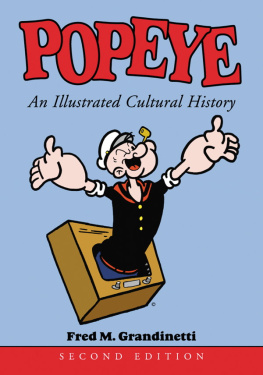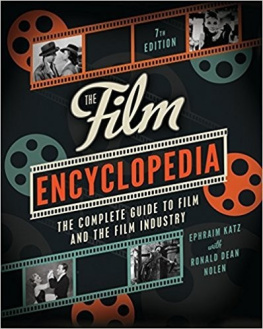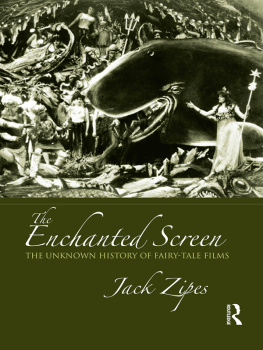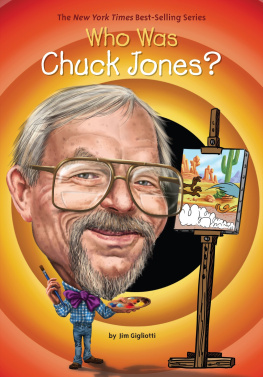
CONTENTS
To E.C. Segar, who created Popeye;
to Max Fleischer, who brought him to the screen;
and to Jack Mercer, who gave the sailor personality
and life with his wonderful vocal characterization
Popeye cartoons and images are reprinted throughout this book by permission of King Features Syndicate. The cover drawing is by the author.
LIBRARY OF CONGRESS CATALOGUING-IN-PUBLICATION DATA
Grandinetti, Fred M.
Popeye : an illustrated cultural history / Fred M. Grandinetti.2nd ed.
p. cm.
Includes index.
ISBN-11: 978-0-7864-1605-9
1. Popeye (Fictitious character) in mass media. I. Title.
P96.P65G73 2004 741.5'0973dc22 2003027765
British Library cataloguing data are available
2004 Fred M. Grandinetti. All rights reserved
McFarland & Company, Inc., Publishers
Box 611, Jefferson, North Carolina 28640
www.mcfarlandpub.com
ACKNOWLEDGMENTS
I am grateful to the following people for their help in making this book possible: Frank Caruso, Ita Golzman, and Mark Johnson of King Features Syndicate; Bill Maling, Craig Davison, Tim Hollis, Jackson Beck, Gordon Sheehan, Leonard Kohl, Mike and Debbie Brooks of the International Popeye Fanclub; Jerry Beck, Steve Bierly, Donnie Pitchford, and Barry I. Grauman. Special thanks go to my family and friends for all their support.
All opinions in this book are those of the author and do not represent the opinions of anyone else who has been connected with the Popeye character over the years.
INTRODUCTION
Having written a number of articles on the career of Popeye the Sailor and being co-founder of The International Popeye Fanclub (also known as the Official Popeye Fanclub) for more than two decades, Im often asked why the sailor has endured for 75 years. I had notions, but the answer came into focus after I had mailed a Popeye doll to The Childrens Room, a hospice for the terminally ill located in Waltham, Massachusetts, in 1993. Though the doll was in great shape, I didnt think much of it because I had found another with Popeyes pipe intact.
Several weeks later I received a call from the woman who ran the hospice, and she told me that the children were going up to the Popeye doll and hugging it for strength. I was surprised that the doll was providing such comfort, but then I recalled moments in the newspaper comic strip and the animated cartoons where Popeye would often assist people in trying times or offer words of comfort without asking for a reward. I realized, throughout Popeyes career in all types of media, he has not only entertained millions through his humorous adventures but also inspired many with his values and beliefs. In fact, The Popeye Club Creed from the 1930s stated that to join, you must be a good citizen to your city, state and country, obey your parents and teachers, lend a hand to young and old when they need help and tell the truth even when it hurts.
I believe Popeye has endured because of his values and the inner strength he provides. This book discusses Popeyes career in various media and the people who helped bring him and his crew to life.
PART ONE
Popeye in Print
Though most people know Popeye from his adventures in animated films, the spinach-eating sailor actually made his debut in newspaper comic strips. Popeye was created by cartoonist and writer E.C. (Elzie Crisler) Segar. Segar was born and raised in the Mississippi River town of Chester, Illinois. He began his varied apprenticeship in the entertainment industry at the age of 12, working in the Chester Opera House, which featured both movies and live performances. He drew advertisements for slide projection and posters and also played the drum to accompany the movies. After completing an 18-month W.L. Evans correspondence course in cartooning, Segar was certified as a cartoonist. He then took off for Chicago, where he found a job on the Chicago Herald.

Segars Thimble Theatre featured stories filled with narrative and humor. Despite his early passing he left behind creations that are now legend.
On March 12, 1916, his first comic strip work appeared in the Sunday funnies when he took over the comic strip antics of Charlie Chaplin in Charlie Chaplins Comic Capers. In 1917 he started a strip called Barry the Boob, featuring a nutty soldier in the European War. Later Segar began drawing for the Chicago American. On June 1, 1918, he began drawing Looping the Loop, a strip that made comic commentary on movies, plays, exhibitions and other doings in downtown Chicago.

Though today Popeye is often thought of as a childrens character, Segars Thimble Theatre strip was written for the adult audience as indicated by this exchange between Olive Oyl and Wimpy.
In late 1919 Segar was sent to Hearsts New York Journal and began work on The Thimble Theatre. Initially this strip starred Olive Oyl and her family: Castor Oyl, her pint-sized brother; Cole Oyl, her father; and Olives boyfriend, pickle-nosed Ham Gravy. Castor and Ham got involved with all sorts of crazy misadventures. On January 17, 1929, Castor was looking for a sailor to run his ship when he ran across an odd-looking, fat-forearmed, pipe-smoking sailor. Castor hailed him: Hey there, are you a sailor? The sailors reply: Ja think Im a cowboy? With that simple remark, Popeye was born.
Olive was based on Chester, Illinois, resident, Dora Paskel. Ms. Paskel was the proprietor of the general store in town. Her physical description certainly matched Olive Oyl! She was tall, lanky and wore her hair rolled tightly in a bun. She also dressed like Miss Oyl, complete with the button-up shoes of the period.

Two early Braccio Di Ferro magazines from the 1930s featuring Segars comic strips in Italian. Popeye continues to be a popular attraction in Italy.

The lore of Chester, Illinois, holds that the character of Popeye was inspired by town resident Frank Rocky Fiegel. Lee Huffstutler, herself a Chester local, makes and well supports this argument. According to Huffstutler, Rocky Fiegel was of Polish descent and lived with his mother in a house near the Evergreen Cemetery. Mrs. Huffstutler describes him as tall, strong, always ready for a fight and always a winner. She once mentioned five local boys who decided to gang up on Rocky and, with all of them involved, win in a fight with him. However, it was not to be. The fight started, five against one, and in short order it was over. Rocky had whipped three of the boys, and the other two couldnt be found anywhere. Once again, Rocky (or Popeye) was the winner even without spinach.
Rocky worked part-time at George Gozneys saloon. When he finished his work and had consumed a couple of beers, he would take a chair outside, seat himself, tilt the chair back, and, with pipe in his mouth, proceed to take a nap in the sunshine. Of course, the sleeping Rocky became an amusing target for the school children who came by. They would creep near, yell loudly, and run. Rocky would awaken with a start and jump out of his chair, arms flailing, ready for a fight. But alas, there would be no opponent. The children would be a block away by that time.
Next page












